How do you do deep tissue pressure massage—without hurting yourself? Lean to generate force. In this article, I’m going to show you how to deliver deep-tissue pressure on a low table.
Step #1: Lean to generate force.
Let’s get into the nuts and bolts of leaning. When teaching I refer to leaning as “fall” and “catch” massage. You let your body “fall” and the client (and/or table) “catches” your body.
Your body weight provides the pressure. And with good body mechanics there’s minimal strain to your neck and shoulders.
I should mention that we’re talking about controlled falling. No black and blue clients.
Here’s what I mean by controlled falling.
You’re going to…
Initiate the fall with your feet.
By simply shifting your weight from your heels to the balls of your feet you begin the fall.
In this pic I’m positioned to fall with my fists. My weight is towards my heels.
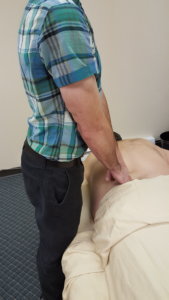
Here I’ve fallen by shifting my weight to the balls of my feet.
.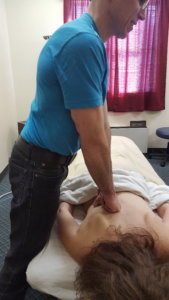
Catch your weight on the table and/or client.
The catching part is practically imperceptible because the body parts you’re massaging with (palms, fists, forearms, thumbs, or knuckles), should be in contact with the person.
You’re simply transferring your body weight forward by shifting your weight from your heels to the balls of your feet.
By the way, look at my shoulders, elbows and wrists in the picture above. Notice how those 3 joints are stacked one over the other. Stacking joints puts less adverse stress in the joints than not having them stacked. It’s a strategy that’s important to execute throughout the entirety of a deep pressure massage.
Okay, to do light to medium pressure, direct some of your body weight into the table as well as the client.
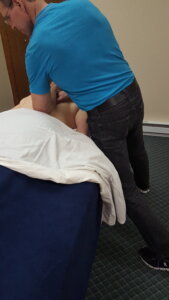
See my leg leaning against the table in this pic? I’m primarily leaning into the table and exerting light pressure through my forearm. (80% into the table; 20% into the client).
For deep pressure direct all of your body weight into the client.
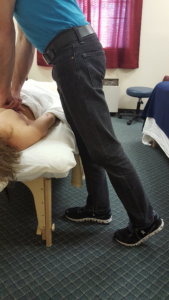
If you “fell” too deep, shift some of your weight back off the balls of your feet.
If you’re having trouble figuring out how much falling (transferring your body weight onto the client and/or table) you should do, keep this in mind: If you are leaning and someone suddenly moves the massage table, you should fall.
Remember that you if you want to put less pressure into the client, lean more into the table than the client.
Okay, here’s the next thing that’s going to save your body when doing deep pressure:
Step #2: Do short strokes.
It’s time to rethink what a makes a stroke relaxing especially when working at a really deep pressure. My opinion in the past was that a relaxing stoke is done at a slow pace and covers a long distance. But over time I realized that it’s difficult, if not impossible, to maintain consistent deep pressure during a long stroke and maintain alignment between your shoulders, elbows and wrists.
On the other hand, if you segment a long stroke, do short strokes instead of long ones, you can maintain consistent deep pressure while staying in good alignment.
I tested this idea out on clients and fellow MTs and no one complained. In fact, they loved it.
The reason why a short stroke allows you to maintain consistent deep pressure is because you’ll never be out of position to lean into the client.
Here’s how I’d segment a long back stroke. Divide the back stroke up into 3 parts—upper, mid and lower. Stand at the side of the table and lean into the area in front of you.
You can position your body so that you are facing the direction of the stroke.
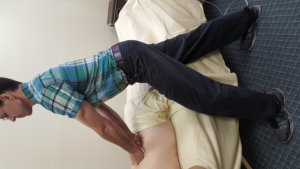
Or you can position yourself so that you aren’t facing the direction of the stroke.
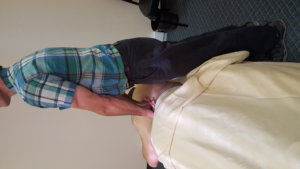
Glide just in the segment area.
Okay, so you did a short stroke, so now how do you get in position to do the next short stroke while remaining in alignment.
Step #3: Move your feet.
Moving your feet is important because that puts you in position to do your next stroke.
Here’s how moving your feet looks: You’re at the end of your short stroke and ready to start your next short stroke. Keep your hands/forearm on the client as you move your feet to get in position to do your next short stroke. This may seem choppy, but it’s not. By having your hands/forearm on the client as you re-position yourself, you’ll maintain contact and consistent pressure. Also, you will keep the same relaxing stroke speed during the next short stroke.
Here’s a video of what moving your feet to get in position for the next short stroke looks like:
Now there is one more key thing you need to know to be able to do deep pressure without hurting yourself.
Step #4: Use the table for support.
When you lean onto your client with all your body weight to deliver deep pressures there should be no strain in your upper-body because your body weight is doing the work.
However, not all my body parts may be happy.
Your back could start talking to you because you’re working on a low table, especially when the client requires less pressure (light to medium).
Less pressure means that you can’t lean all your body weight onto the client so your back and legs have to do more work.
There’s a solution to potential more strain in your back. It’s lean into the table.
How?
Look at the picture below. Do you see how my one leg is pressing into the table?

The leg against the table provides extra support.
That means less work for my back to do and, ultimately, it allows me to change positions so that I won’t be in the massage-hunchback position all the time.
Leaning into the massage table has become a central feature to my body mechanics, so much so that if you randomly pulled the massage table away from me when I was standing during a massage, I would fall on my face 90% of the time.
Here’s what you need to know to experiment with leaning into the massage table.
(1) You can lean into the massage table for support with all sides of your legs (front, back, side, inside).
It doesn’t take much leaning to provide enough support to be able to get you out of massage hunchback.
Here I’m leaning into the table using the inside of my left leg.
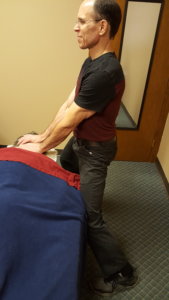
In this next picture I’m leaning into the table with the side of my leg.
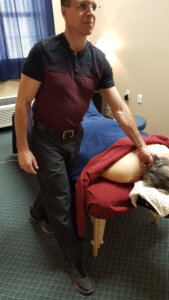
Here’s classic leaning into the front of a leg.
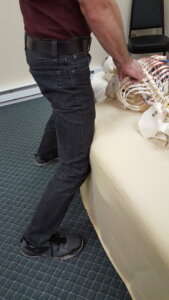
And here’s what you’ve been waiting for: Leaning into the back of a leg(s).
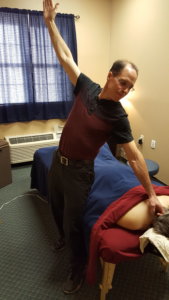
This back of legs leaning position is also a what I call a get vertical position.
Anytime you can lean into the table to support your body weight so that you can straighten your torso is a vertical position.
Here’s another example of getting vertical:

Getting vertical during a massage helps with breaking up static postures, the postures a massage therapist tends to get stuck in during a massage, like hunchback posture.
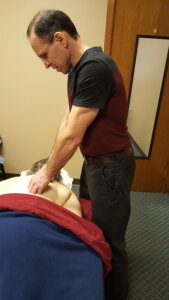
I’ll go into that in more detail below. Here’s the next tip you need to know about leaning into the table:
(2) Think plank when leaning into the table for deeper pressure.
Deeper pressure is going to require more weight onto the client rather than onto the table.
So you’re contact leg that’s leaning into the table is going to help stabilize your “planking”.
Don’t worry about getting more vertical when leaning and doing deep pressure.
Here’s what leaning into the table delivering deep pressure looks like:
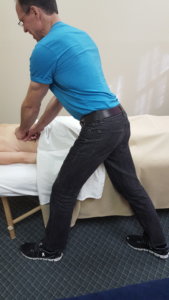
That’s about a 90% lean into the client and 10% lean into the table. The table is helping to stabilize me and the client’s body is supporting most of my weight.
Last leaning into the table tip:
(3) Straighten up and change back positions with light to medium pressure and/or when using one hand to massage.
For light to medium pressure my stances widen because I don’t want to transfer all of my body weight onto the client.
The combination of not needing to exert a lot of pressure and having the support of the table is the perfect opportunity for me to unbend my back.
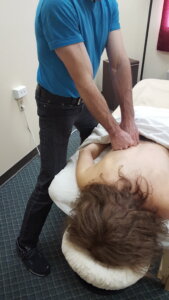
Here’s a one-hand massage example where I’m applying light to medium ischemic compression while taking the opportunity to unbend.
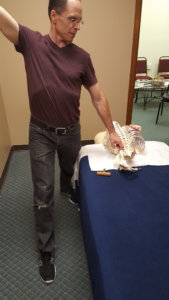
You can also give your legs and back a break by sitting and leaning.
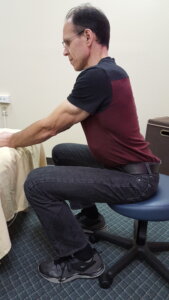
If you want to also give your upper-back and traps a rest, rest your forearms on your quads and lean:
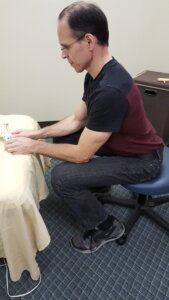
Now that you got the get the basics of leaning, moving and using the table for support, here’s something else that will help you deliver deep pressure effortlessly.
Lean with a Massage Tool
Ever think about using massage tools when doing deep pressure?
If not, you should.
A massage tool can save your hands and elbows, especially if you’re doing deep and focused pressure.
But you can’t be gripping the massage tool like a screwdriver if you want to make deep pressure massage easy on your body. Instead you need to relax your hand(s) and lean.
Lean with a massage tool?
Yep. Just like when you’re using body parts (hands, forearms and fists) to deliver deep pressure, leaning is how you make using a massage tool for deep pressure effortless.
Here are the basics for using a massage tool to deep-pressure focused massage work (aka, saving your thumbs):
(1) Lean into the massage tool to generate pressure.
(2) Use a guide finger to maintain sensitivity.
(3) Use a non-holding hand to stabilize the massage tool.
Take a look at this video. I want you how having two hands on the massage tool makes for some easy going:
Not as scary looking as you thought it might be, right?
My advice for perfecting your deep pressure massage would be to get the leaning down first so that you know how to leverage your body weight. Then it will be easy for you to lean into the massage tool and get comfortable with massage tools.
Massage Mindsets and Physics
Working deep without being in pain comes down to mindsets and physics. We often get locked into beliefs, like “I have to do long back strokes with every relaxation massage”. But that belief can be harmful to your body especially when doing deep-tissue pressure massage.
A better approach to long strokes when doing deep-tissue pressure is short strokes. For example, divide a back stroke up into upper, middle and lower, and only work one segment at a time. By doing so you can effectively lean into the client using your body weight to generate the force. Make sure to stack your arm joints (shoulder, elbow and wrists). Move your feet when you want to start the next short stroke and pivot when you’re out of position to effectively lean. Lean into the table to support your back, adjust your pressure and/or straighten up to get out of hunch-back posture.
Deep-Tissue Pressure Online CEU Course
I have an online, home study How to Deliver Pressure Without Hurting Yourself class.
There are lots of videos and if you have any questions while you’re taking the course, you can always ask me (mark@makethemostofmassage.com).
Check it our here: How to Deliver Deep Pressure Without Hurting Yourself.
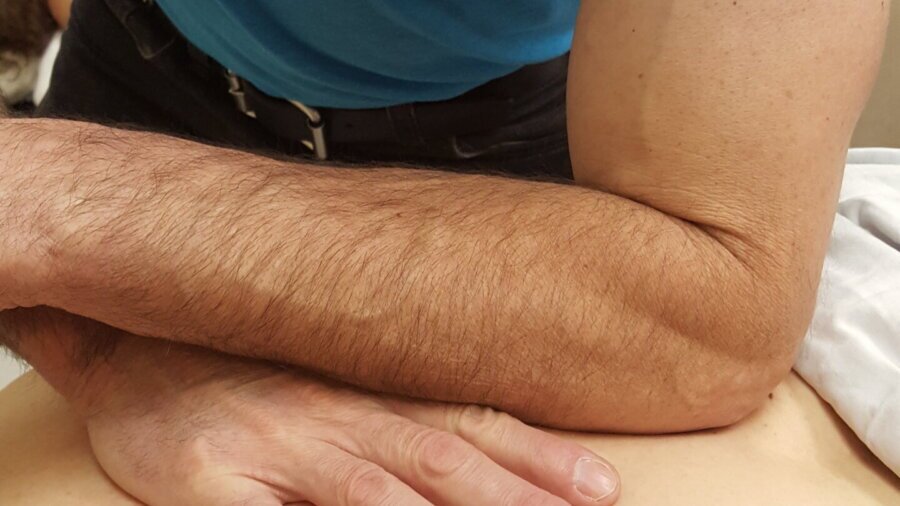


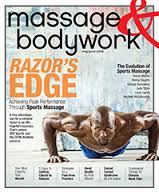
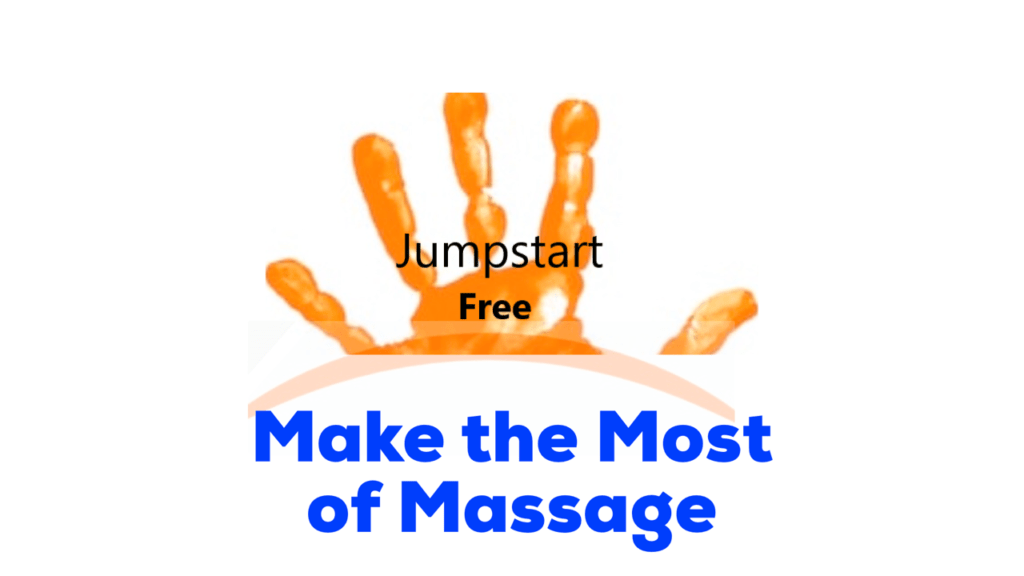

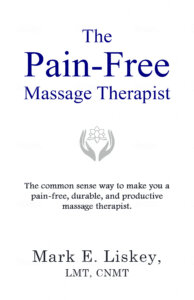
Comments on this entry are closed.